Abraham, fresco in a synagogue in Syria (ca. 239)

Dura Europas was an ancient and obscure military outpost and trading center near the Euphrates River on the edge of the eastern Roman Empire. Its rediscovery in 1932 revealed several important archaeological finds, including a Christian house church and a Jewish synagogue. The synagogue was remarkable for the frescoes that covered its walls. One of the central figures depicted in the synagogue is Abraham, shown receiving God’s promise that Abraham will be the “ancestor of a multitude of nations” (Gen. 17:4). Abraham’s crossed and covered hands portray his acceptance of this promise (on the gesture, see Shabbath 10a in the Babylonian Talmud). Abraham’s white hair reflects the ancient Jewish tradition that “there never was a man upon whom grey hairs were sprinkled until Abraham came” (Pirke de Rabbi Eliezer LII). The vaulted heaven indicates that Abraham’s descendants will be as numerous as the stars. Early Christians, especially Paul, saw the Abrahamic promise as scriptural warrant for the inclusion of the gentiles in the people of God (Rom. 4:13–25).





